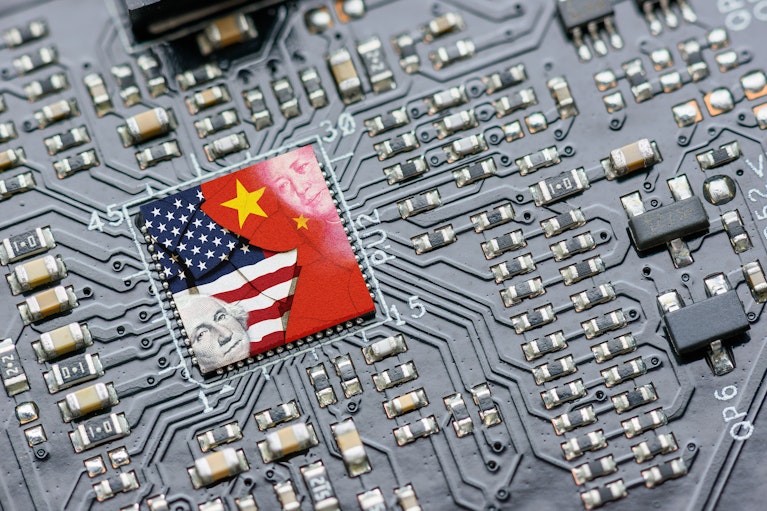Nathan Gardels is the editor-in-chief of Noema Magazine. He is also the co-founder of and a senior adviser to the Berggruen Institute.
Mustafa Suleyman, a co-founder of DeepMind and former vice president for AI products and policy at Google, offers some deep thoughts in his just-released book, “The Coming Wave: Technology, Power and the 21st Century’s Greatest Dilemma” (written with Michael Bhaskar).
The “wave” he sees washing over all aspects of society, for better and worse, is propelled by generative AI and another general-purpose technological innovation — synthetic biology, which, powered by the processing prowess of intelligent machines, can read and rewrite genetic code and then boot up life in the lab. “For the first time core components of our technological ecosystem directly address two foundational properties of our world: intelligence and life. In other words, technology is undergoing a phase transition. No longer simply a tool, it’s going to engineer life and rival — and surpass — our own intelligence,” Suleyman writes.
Intelligent Machines, Humanist Renaissance?
As has been widely discussed, the promise of these innovations ranges from curing cancer to predicting and preventing disease, from creating clean forms of energy, drought-resistant plants and manufactured protein to eliminating the drudgery of rote mental and manual labor while minting vast new wealth that could eradicate scarcity.
LinkedIn co-founder and top venture capitalist Reid Hoffman even sees a new humanist Renaissance on its way thanks to the “amplification [of] intelligence” the coming wave will bring. He analogizes AI to Filippo Brunelleschi’s invention of mobile scaffolding that permitted the thentofore unrivaled construction of the stunning masonry-vaulted dome that crowns the Duomo in Florence. That innovation, in turn, fostered other imaginative leaps by artists, architects, blacksmiths and carpenters that helped fuel the cultural and scientific flourishing in Italy from the 15th to 17th century. Hoffman regards generative AI as “the cognitive ‘mobile scaffolding’” of our time.
Such promise, Suleyman is quick to note, is mirrored in perilous possibilities from displacing gainful employment while concentrating wealth in a few hands to ubiquitous surveillance, industrialized production of misinformation, automated warfare, the pernicious weaponization of pandemics and even the design of master races.
Uncontained Asymmetry
Like earlier general-purpose technologies such as electricity, AI-enabled innovations will inexorably proliferate in scope and scale across every realm of daily life. The momentum of their diffusion will be driven not only by endless entrepreneurial opportunities drawn from massive social demand, but, distinctively, by the distributed nature of AI platforms that are available to anyone and everyone.
The capacities of this phase transition are so consequential for humanity that, in Suleyman’s view, we need to take a different approach than in all previous waves of innovation. “For most of history,” he warns, “the challenge of technology lay in creating and unleashing its power. That has now flipped; the challenge of technology today is about containing its unleashed power, ensuring that it continues to serve us and our planet.” This echoes the general take of Hoffman as well, who argues that “As today’s imperfect Large Language Models improve, requiring less and less from us, we will need to demand more from ourselves.”
Suleyman puts meat on these bones. He departs from the silicon libertarians of his ilk by calling for strengthening the state and other governing authorities to keep the consequences from getting out of control. His remedies go beyond talk of mere regulation to include bringing government and critics into building technology from the start to transparent audits of tech rollouts, the identification of chokepoints to stall or stop innovations and “public input at every level.”
As the title of his book suggests, Suleyman is cognizant of the daunting dilemma posed by pursuing this effort in open societies where the very nature of the distributed technologies that must be controlled erodes the legitimacy of any authority, not least the state, that might do so. Never before in history, which has been mostly characterized by hierarchical political orders, have societies faced common challenges created by technologies that at the same time undermine the capacity for a common response. Suleyman calls this “uncontained asymmetry.”
In Noema, we have noted how the peer-to-peer digital media ecosystem spreads information from private space to private space without forming a public sphere. Absent that solid ground for democratic deliberation through which open societies make the key choices about their future, there is scant hope of addressing the issues Suleyman raises on both the near and far horizon.
For that reason, renovating the practices and institutions of democracy must precede in importance all else, which can only follow from it. Here too, as noted in this column previously, the old paradigm has flipped: Just as republics have historically sustained themselves by establishing institutions and practices that check power when too much of it is concentrated in one place, so too checks and balances are needed in the digital age when power is so distributed that the public sphere itself is disempowered.
As it is now, we are suspended within a contradictory dynamic. As Suleyman sees clearly, “The internet centralizes in a few hubs while also empowering billions of people. It creates behemoths and yet gives everyone the opportunity to join in. Social media created a few giants and a million tribes. Everyone can build a website, but there is only one Google. Everyone can sell their niche products, but there is only one Amazon. The disruption of the internet is largely explained by this tension, this potent, combustible brew of empowerment and control.”
Suleyman has made a major contribution to the discourse with this manifesto calling for governance of both the giants and the tribes in the coming wave. As he so rightly concludes, “The central problem for humanity in the 21st century is how we can nurture sufficient legitimate political power and wisdom, adequate technical mastery and robust norms to constrain technologies to ensure they continue to do more good than harm.”






